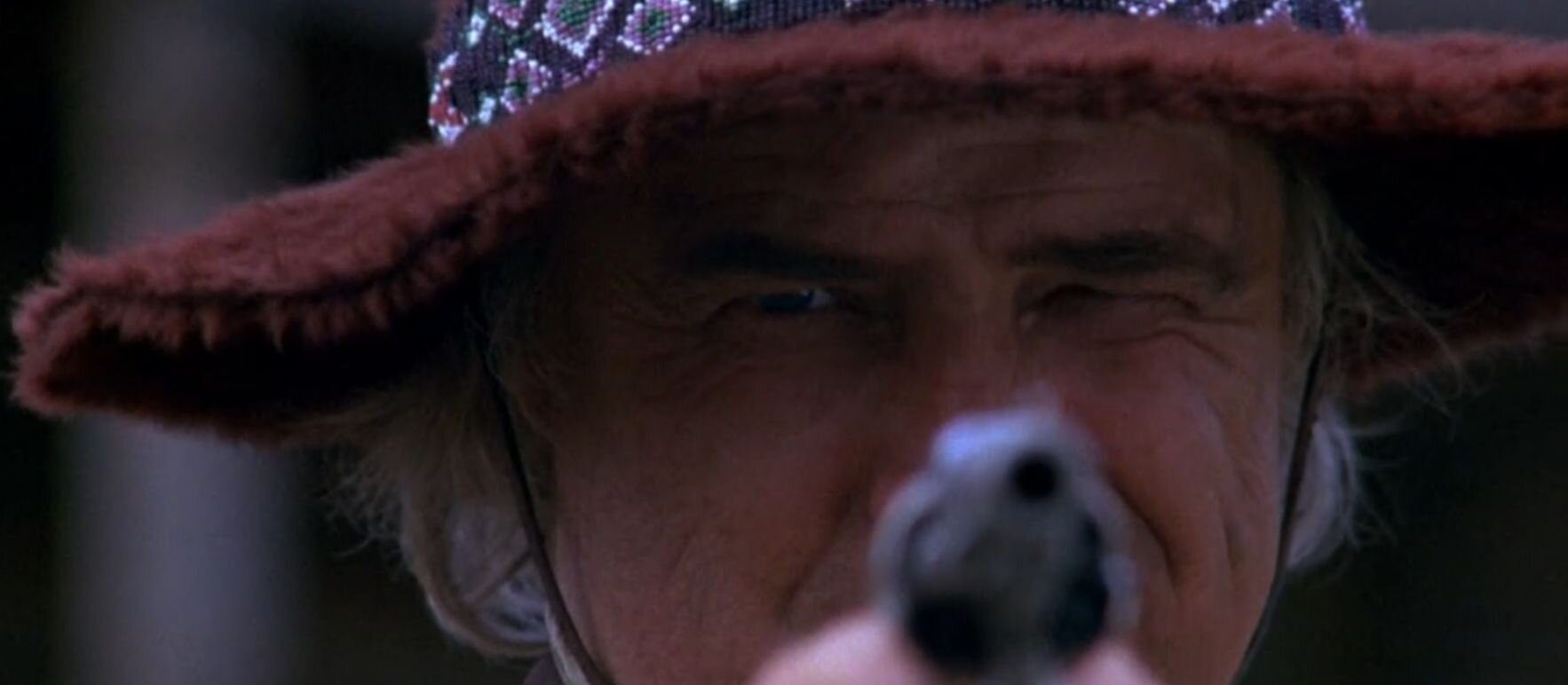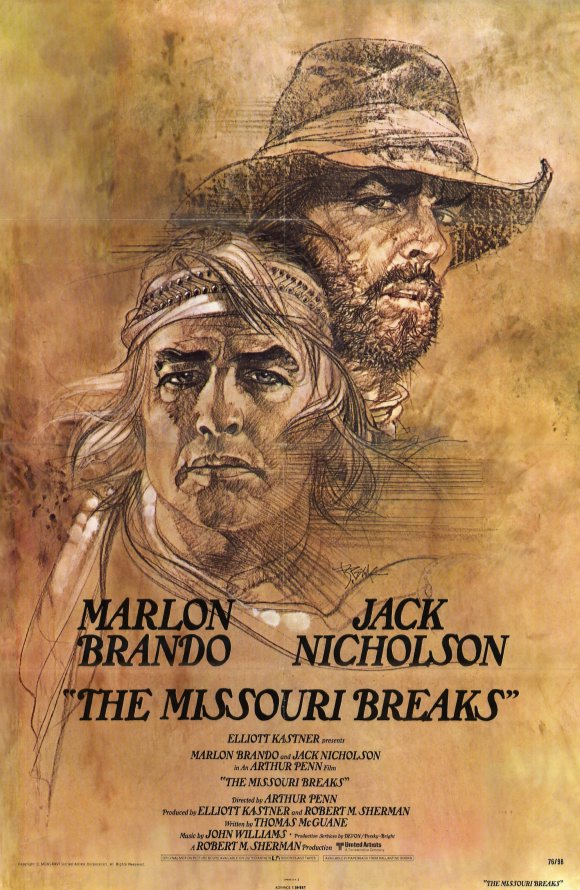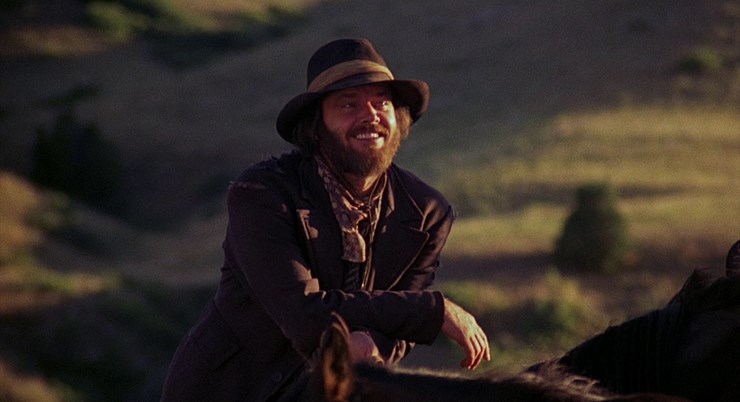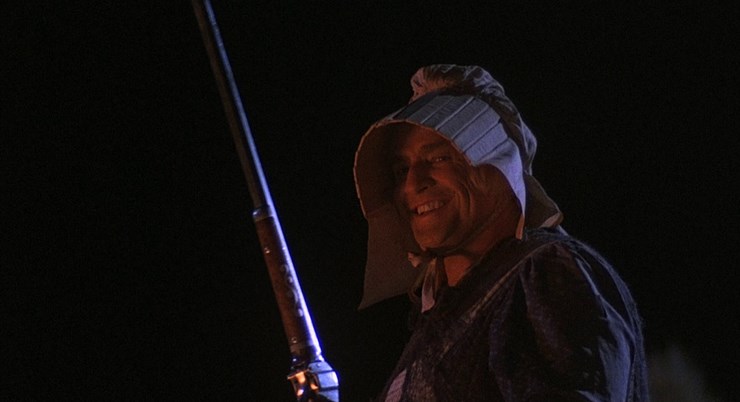

“Well, that’s a fine thing. You pissed right in the middle of my love song.”
M. Night Shyamalan’s Old is set on a mysterious beach where people rapidly age. Shortly after arriving at a luxury resort, the characters realize that several years seem to pass for every hour they spend on the sandy coastline, horribly exacerbating the effects of their various illnesses. Rufus Sewell plays a surgeon who suffers from mild paranoid schizophrenia, but after a few hours on the beach he has nearly lost his mind to an escalating combination of psychosis and dementia. A peculiar outgrowth of his malady is an obsession with remembering the name of an old movie that stars Marlon Brando and Jack Nicholson. Only one such movie exists: a bizarre deconstructionist Western directed by Arthur Penn called The Missouri Breaks.
According to Shyamalan, the story element is derived from a recurring conversation he had with his father, who, like Sewell’s character, suffers from dementia. He teased his father that if he didn’t stop pestering him about the Nicholson-Brando film that he would write about it in one of his own films. And so he did. “For me it represents this thing that someone’s holding onto for their sanity. Everyone must know, these are the two greatest actors of all time, why doesn’t anybody know this? And so they can’t understand this but they’re holding onto it… It was just a kind of funny, sad, beautiful thing about my dad and cinema.” Shyalaman says he’s never seen the film, and thus it’s serendipitous that it fits the situation so perfectly. The thing is, no one knows the name of The Missouri Breaks because, despite featuring two world famous movie stars within a few years of winning Oscars (Brando for The Godfather, Nicholson for One Flew Over the Cuckoo’s Nest), it was a critically panned bomb that’s been largely ignored since its release.
Set in 1800s Montana, the story centers on Tom Logan (Nicholson), a clever horse rustler who has fallen on hard times. When one of his gang members is hanged by Braxton (David McLiam), a rich land baron who has taken the law into his own hands, Logan and his posse get revenge by hanging Braxton’s foreman from the same tree. A severely splintered narrative unfolds from this point on. Logan and Little Tod (Randy Quaid) rob a train in a quasi-comic scene which sees Logan nearly jump to his death when he tries to deboard the detached car which has drifted to a stop in the middle of a rickety old bridge. With the funds procured from the train robbery Logan purchases an old ranch adjacent to Braxton’s property. He begins to take a liking to the simple life and tries his hand at a romance with Braxton’s independent-minded daughter Jane (Kathleen Lloyd); a romance that feels much more at home in the free-spirited hippie years than the Wild West. The rest of the gang—including Cal (Harry Dean Stanton), Si (John Ryan), and Cary (Frederic Forrest)—heads north to steal horses from the Royal Canadian Mounted Police.

Facing staggering losses, Braxton sends for a “regulator” to take care of the horse thievery that has been plaguing his operation. Robert E. Lee Clayton (Brando) arrives on the scene dangling from the side of his horse, wearing a frilly cowboy outfit, tapping his jaw where a toothache pains him, and speaking in a ridiculous Irish accent that shifts around into British and Scottish and at times recalls Brando’s Don Corleone persona and is equal parts mumbles, whispers, and shouts. And so what began as a lighthearted but mildly compelling Western turns into well-produced farce.
I’d be tempted to say that Brando’s oddball turn as the chameleonic hitman “derails” the main narrative. However, the main storyline wasn’t particularly memorable to begin with. Brando though—he’s unforgettable. It is impossible to overstate the eccentric charm and downright weirdness of his performance. In one of his first lines, remarking upon Braxton’s impressive library of law books, he says, “I’m of the opinion—I would only claim books that was about right from wrong. Otherwise how are we to find our paradise among the stars?” Within short order, he’s pilfered ice from an occupied casket to soothe his toothache, told Braxton that the only things not on his diet are the green top of a beet and okra, and professed a love for bird watching. Later he will recreate the spaghetti scene from The Lady and the Tramp with a carrot and his horse, serenade said horse with music from his mandolin and harmonica, and dress up in a pinafore and bonnet and call himself “Old Granny” for no apparent reason.
Despite the fact that Nicholson and Brando’s characters are narratively paired, they rarely appear in the frame together. This is because when Clayton is not ranting preposterously at Braxton, he’s stalking his prey and mostly remains unseen. One by one he picks off the members of Logan’s gang like the side characters in a slasher flick. He takes two of them with their pants down. Si gets shot while pegging the wife of a secluded farmer who graciously hosted him for the evening. Cary catches a bullet in the gut while he’s on the crapper. After taking two victims with his trusty Creedmoor, Clayton brutally dispatches Cal by tossing his homemade “harpoon-throwing-star” into one of his eyes. Perhaps the creepiest hit is Clayton’s drawn out pursuit of Little Tod, which sees him sporting a new accent, playing practical jokes on his new friend around the campfire, and then drowning him in the river. Accounts of the production indicate that Brando was in rare form off-camera as well. He improvised lines, bit into a live frog he found on the river bank, pulled practical jokes, and frequently mooned the cast and crew.

The Missouri Breaks bears many of the hallmarks of the American New Wave (which is perhaps why I cannot convince myself that I didn’t like it despite its myriad shortcomings). There are brief flashes of horrible violence, tender asides, sexual promiscuity, uber-talented leading men absorbing themselves into rugged and weird characters, and explorative camerawork that captures self-consciously voyeuristic scenes. But the film’s most beautiful moments come when the planned shoot is interrupted by randomness or unscripted riffing: an improvised scene in a cabbage patch where Brando tosses an empty revolver to Nicholson (perhaps symbolically passing a torch which had almost burned out under Brando’s watch); Brando dressing up as Old Mother Hubbard before setting the ranch house on fire; a humorous confrontation between Nicholson and Brando as the latter is submerged beneath the suds of a bubble bath; a horse taking a leak while Brando sings himself to sleep. If at first The Missouri Breaks strikes the viewer as madcap and laughable, it offers a bountiful helping of accidental delights and we must applaud its director for allowing his enigmatic star the creative space to bring such a bewildering character to life.
In the end, The Missouri Breaks is a mixed bag. It boasts an expensive, good-looking production that makes great use of its scenery, a subtle score from John Williams replete with banjos, harpsichords and harmonicas, and a stellar supporting cast given enough rope to develop strong personalities (though many are given too little screen time). It’s undercut by a weak, half-finished script and overshadowed Brando’s mystifying performance. While many would cite Brando’s unhinged characterization as the primary reason that The Missouri Breaks fails, I would argue that it is precisely what gives the film its charm and is itself the primary reason to see it. You might get a character like Robert E. Lee Clayton in a modern motion picture. But he wouldn’t be the main character and he’d be finely tuned by focus groups to appeal to specific demographics. While I would certainly like to see the film that might have emerged with a well-behaved Brando starring opposite Nicholson, I’d prefer to see the one that molded itself entirely around Brando’s wild portrayal of Robert E. Lee Clayton, even if no such man ever existed.
Sources:
Mack, Emily. “Jack Nicholson and Marlon Brando’s Bizarre Western: ‘The Missouri Breaks’”. Wide Open Country.